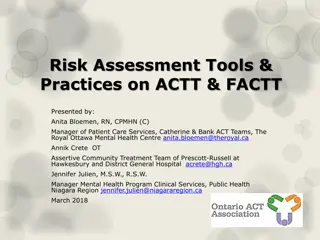Effective Communication and Community Engagement in Health Emergencies Training Programme
This training programme focuses on equipping EMT staff with the necessary skills to communicate effectively with COVID-19 affected communities, patients, and families. It emphasizes building and maintaining trust, integrating health education materials, and outlining the role of EMT staff in delivering health messages. It also includes group exercises on mechanical ventilation, oxygen therapy, isolation protocols, and stress management tips for personal and team well-being during the COVID response.
Download Presentation

Please find below an Image/Link to download the presentation.
The content on the website is provided AS IS for your information and personal use only. It may not be sold, licensed, or shared on other websites without obtaining consent from the author.If you encounter any issues during the download, it is possible that the publisher has removed the file from their server.
You are allowed to download the files provided on this website for personal or commercial use, subject to the condition that they are used lawfully. All files are the property of their respective owners.
The content on the website is provided AS IS for your information and personal use only. It may not be sold, licensed, or shared on other websites without obtaining consent from the author.
E N D
Presentation Transcript
EMT Just In Time Training Modules, COVID-19 Risk Communications & Community Engagement HEALTH EMERGENCIES HEALTH EMERGENCIES programme programme
Session Outcomes Outline the role of EMT staff in communicating health messages to the COVID-19 affected communities with which they are working, including messaging that encourages health seeking behaviors Apply skills for effectively communicating with COVID- 19 patients and their families appropriate to the clinical context Integrate relevant health education communication materials into daily operations HEALTH EMERGENCIES programme
Message Delivery SUCCESSFUL MESSAGE DELIVERY = BUILDING AND MAINTAINING TRUST HIGH TRUST=HIGHER ADOPTION OF HEALTH ADVICE LOW TRUST= LOWER ADOPTION OF HEALTH ADVICE HEALTH EMERGENCIES programme
How to Build Trust Consider factors that influence and/or encourage desired behaviours: Perceived Risk Confidence in public health measure or advice Cultures, norms traditions, beliefs HEALTH EMERGENCIES programme
Group Exercise Critical Mechanical Ventilation Severe Oxygen Therapy Moderate Isolation Mild HEALTH EMERGENCIES programme
Group Exercise 1. Identify which point in the right-hand triangle your scenario is in Provide 3 - 5 key public messages for patients and relatives in the scenario, based on the operational considerations Identify tools and techniques which might be used to achieve a higher success rate in delivery of these key messages Mechanical Ventilation Oxygen Therapy Critical Severe 2. Moderate Isolation Mild 3. HEALTH EMERGENCIES programme
Remember: Community Interaction Also Involves Self-Care What are your tips for personal and team stress management during the COVID response? Taking control over personal work routines (e.g. shift allocations, time-outs) Having healthy daily habits (e.g. sleep, exercise, non-work activities, avoid drug or substance abuse) Buddy-buddy support system Finding ways to communicate Relaxation techniques Positive re-framing Easy access to organisational support systems HEALTH EMERGENCIES programme
Phone Communications with Relatives Cognitive aspects Emotional aspects Personal aspects HEALTH EMERGENCIES programme
Skills Practice Call 1: A call from a relative of a patient who is severe but not critical, e.g. receiving oxygen to help breathing Call 2: A call from a relative of a patient who is critical on a ventilator with no clear indication that he is getting better or worse Call 3: A call from a relative of a patient who is in critical condition and has a possibility of dying within hours or days HEALTH EMERGENCIES programme
What Family Members Need Need to feel hope Need to feel that staff care about the patient Need to be kept informed about progress HEALTH EMERGENCIES programme
Thank you Any questions? For more http://extranet.who.int/emt/ EMTeams@who.int HEALTH EMERGENCIES programme























